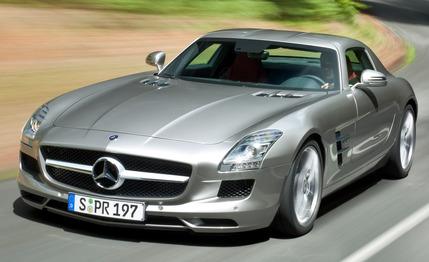
 Second Drive
Second Drive
Let’s start with an unassailable premise: In a corporate history overflowing with exceptional automobiles, few if any have more enduring cachet than the Mercedes-Benz 300SL Gullwing coupes of 1955–57. It’s no exaggeration to call them automotive immortals, which makes the prospect of a contemporary sequel downright daunting to those responsible for its execution—the denizens of AMG, Mercedes’ in-house performance division.
AMG has an impressive track record for creating sophisticated hot-rod versions of just about every vehicle Mercedes produces. But the 2011 SLS AMG is different. AMG says the car shares no structural elements with other Benzes and was created to “show how sporty a Mercedes can be,” according to Thomas Weber, Benz’s head of research and development.
No question about the sporty part. The latter-day Gullwing is a bullet, covering 0 to 60 mph in a claimed 3.7 seconds, a forecast we feel we can beat by a couple tenths. A top speed of almost 200 mph. The agility and precision of a high-wire acrobat. Bulldog grip. Massive braking power. But in the context of today, is the SLS AMG as sensational as its legendary ancestor? Is it fabulous? We’ll get back to that. But first, a little hardware review.
Aluminization
The SLS, which goes back to concept sketches created nearly five years ago, was rooted in two fundamental principles: minimal mass and maximum structural rigidity, goals that aren’t exactly parallel. To achieve these objectives, the design that emerged was a unitized aluminum space frame and aluminum body shell.
Bodies are fabricated by Magna Steyr in Austria, which also contributed to the Gullwing’s design. Then they’re shipped to the Mercedes facility in Sindelfingen, Germany, where they’re united with aluminum control-arm suspension components, a 6.2-liter V-8, a carbon-fiber driveshaft, a seven-speed dual-clutch automated manual transaxle (from Getrag, and specific to this car), and a limited-slip rear differential. It all adds up to a car that weighs about 3600 pounds and has a sense of structural solidity we’d associate with something much heavier. A railroad trestle, for example.
Amplified 6.2-liter V-8
The engine is AMG’s familiar 6.2-liter, 32-valve DOHC aluminum V-8, referred to as the 6.3 in company propaganda, commemorating the engine that propelled the brutal AMG Hammer. But the SLS version packs a bigger punch than the standard 6.2. Upgrades are extensive and include dry-sump lubrication, revised camshafts, a stiffer crankcase, a stronger crankshaft, and a low-back-pressure exhaust system, for a total of 563 hp and 479 lb-ft of torque.
The new Getrag seven-speed transaxle handles the thrust via multiple operating modes, and its “brain” is a quick learner. During lapping at California’s Mazda Raceway Laguna Seca, the gearbox quickly picked up the rhythm of the circuit and began executing perfectly timed downshifts on corner entries.
This was not unwelcome, since the Laguna Seca routine for this event had us following five-time German Touring Car champ Bernd Schneider. His lead-follow technique went like this: Run a moderately hot lap, then check the mirrors. If the civilians are still within sight, turn up the heat on the next lap. And so on. Inevitably, despite considerable experience with the storied track, your humble narrator struggled to hang onto the flying German as speeds picked up and the laps zoomed by. His smooth lines never seemed to vary by more than an inch or two, while ours began to be increasingly untidy, marked by a certain amount of slithering around on corner entries and more slithering when we picked up the throttle on exits.
Although the SLS isn’t a torque monster like the SL65 AMG, picking up the throttle can produce more results than one might have planned, particularly from low speeds, even with the three-stage stability control in its normal default setting. The thresholds are high, and power oversteer is definitely achievable. Do not stab the throttle. Ease it on. That is, unless you’re hanging it out for the camera.
Circuit Revelations
The take-away from the Laguna Seca experience is that the SLS might not be quite as well suited to track work as some of its competitors are. The Audi R8 comes immediately to mind. Bernd Schneider is certainly smooth, tidy, and fast in this car, but he was also one of its development drivers. And besides, he’s Bernd Schneider, and we’re not.
The SLS has plenty of grip from its fat Continental tires (265/35-19 front, 295/30-20 rear); the speed-sensitive, variable-assist power steering delivers feel and accuracy that approach perfection; the brakes are formidable; and, of course, there’s no shortage of power. But for all that, there was sliding around that came on with little or no warning. This chassis is exceptional, but for some reason it wasn’t telling us everything we needed to know about its limits.
We hasten to add that these little episodes of slippin’ and slidin’ weren’t remotely fraught with peril or even excessive drama. Still, they did add seconds to our lap times. And the responses of the transmission in pure manual mode seemed a little slow compared with those of other dual-clutch units we’ve encountered. Perhaps more track time would improve our performance and thus our reaction to the SLS as a track-day ride? We’re happy to volunteer.
And there are definitely racetracks in this car’s future. One of the revelations of this preview was that the SLS will serve as the official Safety Car for the 2010 Formula 1 World Championship. It’s a hallowed AMG tradition, and according to AMG boss Volker Mornhinweg, the cars are already set up and ready to go.